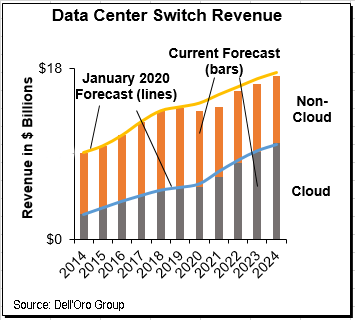Dell’Oro Group just published an updated forecast for the enterprise Wireless LAN (WLAN) market, and expects demand to be robust over the next five years, growing to almost $9 B, as Wi-Fi becomes the default connectivity option for users and devices. In spite of a severe worldwide economic downturn, the enterprise WLAN market has proven remarkably resilient in 2020—revenue is on track to decline modestly supported by remarkable government stimulus that became available in 3Q20. We estimate government funding to grow to a disproportionate portion in 2021, which means the magnitude and duration of funding could move the market significantly.
One of the big winners in 2020 was cloud-managed WLAN: adoption of cloud-managed Wi-Fi access points jumped by 6 points in 2020 as the pandemic triggered interest in remote management capabilities, given the difficulty of visiting locations in person. However, going forward, we don’t expect this surge to continue, rather we expect adoption to grow at a more moderate pace as businesses balance the need to manage a distributed network with the desire to maintain control over their data. Issues such as high priced egress fees, and disputes over who owns the data have emerged and need to be resolved.
We were surprised to learn enterprise class Wi-Fi 6E access points are planned for the summer of 2021, as most vendors we spoke with were planning six-to-nine months later. Another surprise was the first products will be 2×2 rather than 4×4. Lower-end products spearheading a technology transition is different from previous technology introductions, and has a huge implication on market penetration, and moving the market. The obvious first impact could be users delaying purchases as they wait for 6E products from their favorite supplier, with the most notable pause coming from the high-end and high portion of the midrange market. We forecast 6E to fuel the market growth through the forecast horizon.
Our discussions with system integrators indicate a notable increase in deployments of competitive wireless technologies (5G, private cellular, Broadband Fixed Wireless) in 2020, particularly from schools and municipalities connecting constituents during the pandemic. We believe the impact on the WLAN market will be limited, as Wi-Fi is not a good fit for these types of deployments due to range, and coverage requirements. There is an opportunity for vendors to build network management systems that bring these different networking technologies together under one roof.
In sum, we address factors suppressing as well as accelerating the WLAN market in our forecast report. One of the main drivers of traffic and network upgrades—the growth engine—is people returning to work.
About the Report
|



 About the Report
About the Report About the Report
About the Report